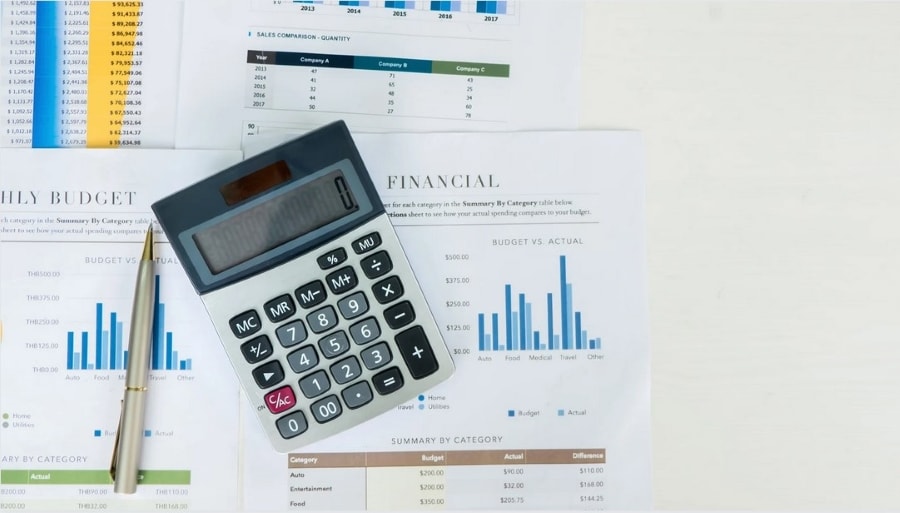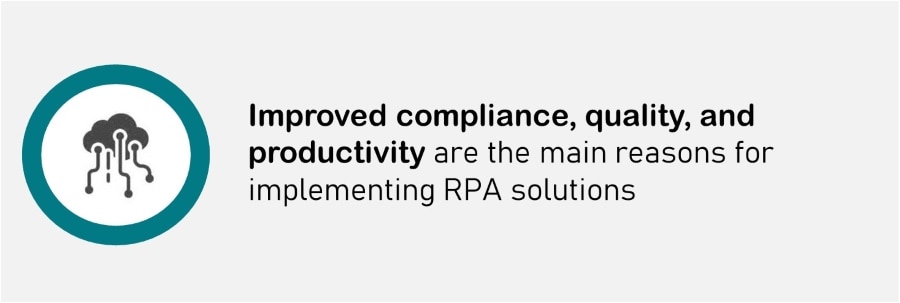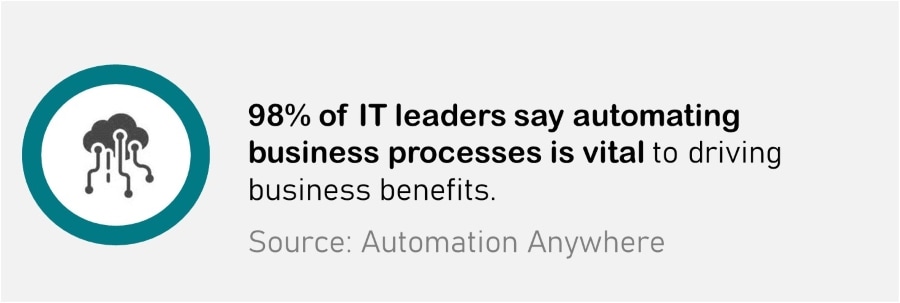RPA in Finance and Accounting: 10 Robotic Process Automation use cases in Fintech

Robotics Process Automation (RPA) in finance and accounting is swiftly changing day-to-day operations, in some cases, faster than any other technology.
RPA software automates mundane, repetitive, rule-based processes, enabling accounting staff to devote more time to serving clients and other higher-value work.
RPA is an effective solution in many areas of finance and accounting since it reduces processing times, minimizes entry errors, and lowers costs.
Understanding how Robotic Process Automation (RPA) works
RPA uses artificial intelligence to eliminate errors and automate repetitive, high-volume tasks. It is not even necessary to automate the entire process to be beneficial. Rather than that, it can automate specific steps in a lengthy process, which has been a significant driver of its adoption.
RELATED: Business benefits of artificial intelligence
RPA comprises software robots, colloquially referred to as bots, representing a reusable task and process automation pattern. Bots perform some human-like functions, such as reading a screen in one application and copying and pasting relevant text into another.
Businesses can leverage RPA platforms to develop, monitor, manage, repurpose, and secure bots and their activities.
How is RPA used?
The simplest bots replicate and capture the repetitive human workflow. This simple bot serves as a starting point for a bot developer to build a more robust bot that is less likely to break if a screen on an app changes slightly.
RELATED: How Big Data and AI can deliver results
Other artificial intelligence (AI) technologies, such as optical character recognition (OCR) for extracting text from paper documents and machine learning for determining which fields in an invoice correspond to areas in a finance application, are frequently used in conjunction with bots.
RPA is best suited when there are significant potential savings in time and money. In areas where operations begin with a high level of quality, the processes are rule-based and standardized. Otherwise, by automating chaos, you will end up with automated disorder.
With its accounting and procurement divisions, finance satisfies both of these criteria. It is well-known as a business function for repetitive, time-consuming tasks such as data entry, reporting, cross-checking, and record-keeping, which is ideal for RPA bots.

How RPA Benefits Finance and Accounting
Few industries benefit from robotic process automation more than finance and accounting. Due to the high-volume and repetitive nature of finance and accounting, the benefits of robotic process automation include the following:
- Scalability – When transaction volume reaches a certain level, you may need to hire a new team member to assist with workload management. However, with RPA, this is no longer required since when the workload increases, the bot’s output can be scaled as needed.
- Innovation – With the ability to extract both legacy and new data from existing systems, RPA can automate data analytics and provide deeper insights to help businesses make the best decisions possible.
- Efficiency – Repeated tasks require time. With RPA, you can significantly reduce the time needed for your team to complete necessary tasks, allowing them to focus on more high-level and strategic initiatives.
- Compliance – Finance and accounting require a high level of attention to detail to remain compliant. Your organization can suffer significant financial setbacks with a single misstep. RPA software automatically improves your team’s accuracy by eliminating potential human errors.
Let’s look at nine use cases specifically in accounting and finance to understand how RPA is used in the real world:
Ten RPA use cases in finance and accounting
1. Remediating discrepancies in data
Once poor data enters the system, it spreads rapidly across multiple repositories. This may necessitate significant data cleaning and correction work downstream.
Robotic Process Automation can scan the data, identify issues, and bring them to a team member’s attention for review. Finally, once the correct data has been identified, a bot can programmatically correct the data issue across all impacted systems.
For instance, RPA can identify inconsistencies between systems by utilizing multiple rules to ascertain the source of the inconsistency.
A team member flags the resulting decision for review and approval. Once a team member approves the change, the bot updates the relevant system. This resulted in an improvement in the data quality across all systems involved.

2. Accounts Reconciliation
While crucial, comparing account balances across systems can be a time-consuming function. This can consume valuable time when logging in and out of various systems.
Whether there are concerns about a chain of transactions or you simply need to perform a periodic ledger reconciliation as part of your compliance measures, reconciliation tasks can equate to time staring at Microsoft Excel.
RPA robots can easily handle most of these tasks’ fundamental components, requiring human intervention only when data does not align as expected.
Robots can take over the repetitive tasks associated with each entry, resulting in more productive audit outcomes.
3. Invoice and PO Processing
Invoices are a constant source of frustration for back-office staff, even when they arrive in various formats. A robot can handle this process, just as it can take PO processing.
Staff members can spend a significant amount of time processing purchase orders and routing them for approval to acquire critical goods and services for the business.
Software robots could be configured with intelligent data capture tools to scan purchase orders for critical information, enter it into the appropriate system, and initiate an approval request.
When data is significantly different from expected, it can flag an invoice for manual user review.
In both cases, OCR can assist with reading paper documents, while machine learning can help map data from the documents to the record system.
4. Accounts Receivable
Cash management is a critical component of the accounts receivable process. Applying the correct payments to the correct accounts and invoices is a complex process that includes numerous opportunities for error.
Accounts receivable management is critical because it is directly related to cash flow. Accounting teams spend a significant amount of time filling in data and tracking payments within disparate systems.
Additionally, there is a high margin for error if a single record is entered incorrectly, affecting payment. Therefore, robotic process automation can automate invoice payments’ creation, transmission, and tracking, significantly reducing late payments.

5. Accounts Payable
As with accounts receivable, accounts payable is a critical repetitive function of accounting teams. In contrast to accounts receivable, accounts payable require that vendor invoices be reconciled to purchase orders before payment.
Again, this results in a lengthy and data-intensive process. However, this is not the case when robotic process automation is used. RPA distributes incoming invoices automatically to the appropriate recipient and can help prevent late payments by scheduling reminders.
Additionally, RPA can easily reconcile purchasing orders and invoices to ensure that everything is in order.
6. Financial Planning & Forecasting
Financial statements and data must be correctly entered and maintained to forecast the future accurately. Your data will be correctly collected, transformed, and stored for forecasting purposes through bots.
By combining historical data from multiple departments, automation solutions can create a comprehensive financial forecast and then seamlessly conduct variance analysis with this data.
7. Financial Reporting
It is critical to provide accurate information to decision-makers, and this information flow requires precise and detailed reporting.
Numerous businesses use RPA to automate financial reporting, particularly those that must provide daily reports to management.
RPA can significantly reduce the number of manual, repetitive, and time-consuming tasks, resulting in significant processing time savings and early access to reports with substantially higher accuracy.
For example, the following reporting processes can be automated with application bots:
- P&L
- Income statements
- Trial balance and balance sheets
- Variance analysis
- Regulatory/management reports
- Financial close processes
Your finance department can easily prepare current financial statements using RPA, even on a daily basis. Your business leaders can make the most informed decisions and act with agility when they have the most up-to-date financial information.

8. Travel and Expense Processing
When your employees travel on business, they expect to be reimbursed promptly. As travel resumes, the number of expense reports will increase as well.
As a result, your accounting department will become overwhelmed with the task of comparing receipts and expense reports before authorizing payouts. Rather than that, you can automate this process using robotic process automation.
Software robots can take submitted data, compare it to internal policies, and notify the accounting team of whether expense reports adhere to reimbursement policies.
9. Client Onboarding
Financial institutions must conduct due diligence before onboarding new customers under the Know Your Customer (KYC) regulations. This can quickly devolve into a draining exercise that eats up their valuable time.
Rather than spending time combing through various systems to gather information, RPA bots can be used to accomplish this task in a fraction of the time. Once the bots have collected data, they can send a detailed report to the compliance manager or other individuals responsible for reviewing and approving onboarding.
If a new customer is approved, the bot can also populate the CRM or customer profile with all pertinent information.
10. Managing data
Data is a vital asset, but it can be underutilized when fragmented and challenging to access. Finance teams frequently have to manage data stored in multiple systems, which can often be an inefficient use of their time.
RPA can improve data management across these systems by enforcing business rules to assist in the movement and transformation of data between systems to execute processes, conduct analyses, and generate valuable reports.
RELATED: 5 data security best practices for keeping your data safe
IT teams can develop RPA finance automation to trigger specific events in these systems, or they can schedule bots to run at specific times to complete a process.
Individuals can then devote their time to more judgment-based tasks such as reviewing and validating the updated data.

Next Steps: 5 tips for Implementing RPA in Finance and Accounting
Given the relative ease of implementing RPA, businesses can establish a foundation for future growth in automation as technologies mature and develop. Today’s investment may yield unexpected dividends as new automation opportunities emerge.
The best part about robotic process automation is that once implemented, you will see a near-instant return on investment.
Consider following these steps to get started on your RPA implementation:
- Identify Processes – In order of complexity, list all the manual, repetitive, high-volume business processes your Finance and Accounting team spends time on.
- Document Requirements – Take an objective look at the processes listed above. If any improvements can reduce waste, then make a note of them. Additionally, document the steps involved and the relevant parties so that when you deploy RPA, everyone can be on board.
- Prepare the Data – RPA relies on accurate and structured data to execute processes properly. Ensure you know where data must be extracted from for the RPA solution to do its job. Ideally, try to consolidate data into a centralized location.
- Design the Process – Define the steps of the process and the intended end goal. Establish stop points where your team can review the work and verify that all is working smoothly.
- Test the Output – Start with a small test before deploying RPA on a broad scale. A pilot test will help you gauge whether or not your data is complete and accurately processed by the RPA software. Solicit feedback from all team members who are usually part of the process to assess if everything is running as you hoped. If all looks good, you can continue expanding your RPA solution usage.

